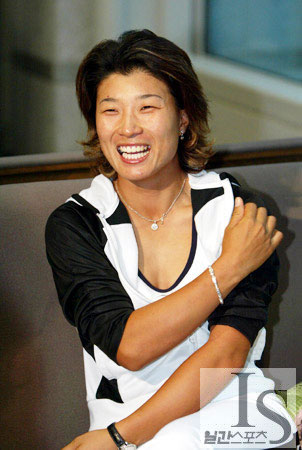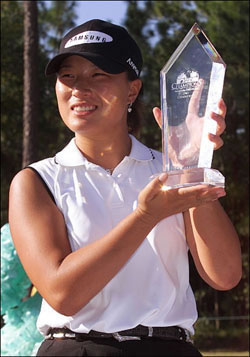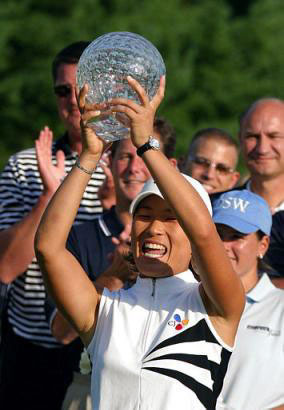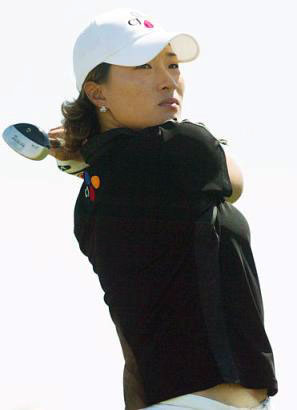 |
 |
 |
 |
 |
 |
Editorial: Whither Se Ri?
Se Ri Pak has been a phenomenal player almost since the moment she first arrived on the LPGA tour in 1998 (even before that, really; she set a record at Q-School the year she qualified). In the six full seasons she has played before this year, she has been second on the money list four times, third once and 12th in 2000.
But the problem with being second, and as good as Se Ri undoubtedly is, is that she no longer gets compared to other great but lesser players. Her achievements always necessarily get compared to the one player who has beaten her in those three years, Annika Sorenstam. And consistently, despite Se Ri's best efforts, she has fallen short of the standard Annika has been setting.
Now we stand at the start of the 2004 season, and nothing much has changed. Despite Se Ri's intense off-season workout regimen, despite a seemingly improved swing, once again, Annika sits atop the money list with wins in two of her first three starts. Meanwhile, Se Ri has gotten off to a weaker start even than normal; she has four top twenties, but has not seriously contended even once in those four starts. Se Ri is in danger of giving Annika yet another insurmountable lead in the money list and Player of the Year standings.


Se Ri holds one of her five trophies
from 2001
2000 was a bad season for Se Ri Pak, though a good one for most any mortal. She could not manage a single win that year, though she has never had fewer than three wins in any other year. 2001 can therefore be seen as her 'comeback' year; that season she managed five wins including a Major, and duplicated that feat in 2002. In 2003 she did not win a Major but still finished second on the money list, made more than $1.5 million, and had three wins. How does 2004 so far compare to those previous seasons? Is she succeeding in her goal of getting closer to Annika Sorenstam? Or is she slipping further behind?
One of the most interesting, and frankly worrisome, stats we can examine is her winning frequency. Dating back to the start of the 2001 season, look at the number of events that would occur between Se Ri victories:
2001
Your Life Vitamins (win)
5 events
Longs Drugs Challenge (win)
5 events
Jamie Farr Kroger Classic (win)
1 event (and that one was nearly a win as well)
British Open (Major)
2 events
AFLAC Tournament of Champions (win)
4 events (including 2002 events)
In the 2001 season, Se Ri Pak never had more than 5 losing events between wins, and once she got into the best part of her season, she was contending almost every week. Now let's see if the pattern continued in 2002:
2002
Office Depot (win)
4 events
LPGA Championship (Major)
7 events
Betsy King (win)
3 events
Mobile Tournament of Champions (win)
0 events
CJ 9 Bridges (win)
3 events (to 2003)
In 2002, Se Ri did have a stretch of 7 winless events in the middle of the season, but otherwise kept up the pattern of 2001: not many events between wins. Now how about 2003?
Safeway Ping (win)
3 events
Chick-Fil-A (win)
9 events
Jamie Farr Kroger Classic (win)
14+ events

Se Ri hoists her most recent trophy,
from the 2003 Jamie Farr Kroger
Classic
You can see that Se Ri's pattern continued until the Chick-Fil-A. But then, suddenly, something changed. Her nine event winless streak in mid-2003 was her worst since her rebirth in 2001. But even that has not been as bad as her current streak: 14 winless events (and counting), by far her worst since 2001.
So Se Ri's average winless streak before the Chick-Fil-A, a period of two and a half years, was about 3 and a third winless events between wins. Her last two winless streaks have been far far longer than that. What's happening to Se Ri? Why this significant difference?

Se Ri at last year's British Open
Her performance in the Majors shows a similar downward turn. At one time, Se Ri was known for her ability to turn it on when the course was difficult. After all, she won arguably the hardest US Women's Open ever played, at Blackwolf Run in Wisconsin. But when you look at her recent career finishes in Majors, a familiar pattern becomes evident (good finishes are bolded):
2001 Majors:
Nabisco: T11
LPGA Championship: T39
US Women's Open: 2nd
British Open: Won
2002 Majors:
Nabisco: T9th
LPGA Championship: Won
US Women's Open: 5th
British Open: T11th
2003 Majors:
Nabisco: T15th
LPGA Championship: T46
US Women's Open: T50
British Open: 2nd
2004 Majors:
Nabisco: T16th